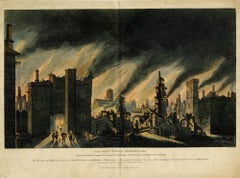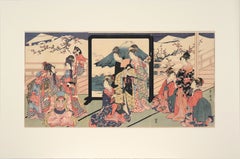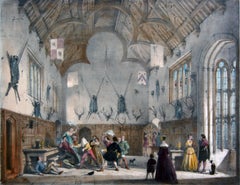James Stow Interior Prints
to
1
Overall Width
to
Overall Height
to
3
106
79
37
30
1
1
1
1
1
1
1
1
1
1
Artist: James Stow
The Great Fire of London, 1666
By James Stow
Located in Middletown, NY
A rare early 19th century view of the Great Fire of London over Ludgate, enhanced with hand coloring.
London: Robert Wilkinson, 1811.
Copperplat...
Category
Early 19th Century English School James Stow Interior Prints
Materials
Handmade Paper, Engraving, Watercolor
Related Items
"Toy Horse Dance" Japanese Woodblock Triptych with Beauties and Mt Fuji
Located in Soquel, CA
"Toy Horse Dance" Japanese Woodblock Triptych with Beauties and Mt Fuji
Vibrant three-panel woodblock print by Utagawa Toyohiro (Japanese,...
Category
Early 20th Century Edo James Stow Interior Prints
Materials
Ink, Rice Paper, Woodcut
Utagawa Toyohiro"Toy Horse Dance" Japanese Woodblock Triptych with Beauties and Mt Fuji, early 1900s
$1,700
H 24 in W 36 in D 0.25 in
Mid 19thCent. Kings Hall Party Session, Athelhampton, Dorsetshire by Joseph Nash
By Joseph Nash
Located in Soquel, CA
Historical mid-19th century hand tinted lithograph and a lively scene of men and women engaging in a light hearted game of the era by artist Joseph Nash (British, 1808-1878). Signed ...
Category
Mid-19th Century Victorian James Stow Interior Prints
Materials
Watercolor, Lithograph
$850
H 27 in W 22 in D 2 in
Kabuki actor Nakamura Shikan II by Utagawa Kunisada Edo Japanese Woodblock Print
By Utagawa Kunisada (Toyokuni III)
Located in Soquel, CA
Kabuki actor Nakamura Shikan II by Utagawa Kunisada Japanese Woodblock Print
Wonderful portrait of Nakamura Shikan II, a prominent kabuki actor, in the role of Kisen Hoshi Toyokuni ...
Category
1820s Realist James Stow Interior Prints
Materials
Printer's Ink, Rice Paper, Woodcut
$550
H 21.75 in W 16.75 in D 1.25 in
Chester Cathedral - Drypoint Etching in Ink on Paper
Located in Soquel, CA
Chester Cathedral - Drypoint Etching in Ink on Paper
Dramatic drypoint etching by J. Alphege Brewer (British, 1881-1946). This composition shows the interior of Chester Cathedral in Brewer's characteristic style - highly detailed and with strong contrast. The scene encompasses the cathedral from floor to ceiling, capturing the immense size of the building. There are several people in the scene which contribute to the sense of scale.
Signed by hand "J. Alphege Brewer" in the lower right corner.
Titled "Chester Cathedral" in plate, lower left corner.
Includes original card with artist's name.
Presented in a new black mat with foamcore backing.
Mat size: 16"H x 12"W
Paper size: 10.75"H x 7.75"W
James Alphege Brewer was well known in the early 20th century as a producer of color etchings of European cathedrals and other scenes of church, college, and community. He was born July 24, 1881, in the Kensington section of London, England, the son of Henry W. Brewer, noted artist of historical architecture and prominent convert to the Catholic Church, and the grandson of John Sherren Brewer, Jr., “the brilliant editor of the Calendar of Letters of Henry VIII.” His great uncle was E. Cobham Brewer, the polymath who compiled Brewer’s Dictionary of Phrase and Fable. Among his older siblings were the artist Henry C. Brewer and the organist and writer John Francis Brewer.
Brewer attended the Westminster School of Art in London, where his brother Henry also trained. In 1910, he married Florence Emma Lucas, an accomplished painter in oil and watercolor, whose father was the noted landscape artist George Lucas and whose great uncle was David Lucas, the famous engraver for John Constable. Florence's brothers Edwin and George assisted Brewer in the printing of Brewer's etchings.
Brewer exhibited at the Royal Academy (RA) and the Royal Institute of Painters in Watercolour (RI), at the Paris Salon of the Académie des Beaux-Arts, and in the shows of the Royal Cambrian Academy (RCA). He became an associate of the Royal Cambrian Academy in 1929 and a full member in the last two years of his life. He was also a member of the Hampstead Society of Artists, the Society of Graphic Art, and the Ealing Arts Club, where he was first Honorary Art Secretary and then Honorary Art Chairman. Most of Brewer's larger etchings were published by Alfred Bell...
Category
Early 20th Century Romantic James Stow Interior Prints
Materials
Paper, Ink, Drypoint
$396 Sale Price
20% Off
H 16 in W 12 in D 0.25 in
Deutzia Flowers: The Wife of Kasamori - Original Woodblock Print
Located in Soquel, CA
Deutzia Flowers: The Wife of Kasamori - Original Woodblock Print
Deutzia Flowers: The Wife of Kasamori, from the Series "Beauties of the Floating World Associated with Flowers" by S...
Category
1760s Edo James Stow Interior Prints
Materials
Woodcut, Ink, Rice Paper
$900
H 18 in W 14 in D 0.5 in
G. Paterson "Dinner Party at a Mandarin's House" Engraving After T. Allom c.1840
Located in San Francisco, CA
G. Paterson "Dinner Party at a Mandarin's House" Original Engraving After T. Allom C.1840
Original engraving
Dimensions 8" wide x 5" high
The frame measures 20.5" wide x 18.5" hig...
Category
Mid-19th Century Realist James Stow Interior Prints
Materials
Engraving
$250
H 18 in W 20.5 in D 0.5 in
James Dobie "The New Will" Color Engraving After Walter Dendy Sadler c.1894
Located in San Francisco, CA
James Dobie "The New Will" Color Engraving After Walter Dendy Sadler c.1894
Original 19th century color engraving
Engraved by James Dobie after artwork b...
Category
Late 19th Century James Stow Interior Prints
Materials
Engraving
$375
H 23.5 in W 28 in D 2 in
In the cafeteria - Figurative Drypoint Print, Colorful, Polish Art
By Czeslaw Tumielewicz
Located in Warsaw, PL
Colorful figurative drypoint print by Polish artist Czeslaw Tumielewicz. Artwork depicts two people kissingDon Kichote on a horse, attacking a surreal windmill. They are shown in rat...
Category
Early 2000s Contemporary James Stow Interior Prints
Materials
Paper, Drypoint
$330 Sale Price
20% Off
H 10.83 in W 8.08 in
Annual Events for Young Murasaki (July) - Tales of Genji - Japanese Woodblock
By Utagawa Kunisada (Toyokuni III)
Located in Soquel, CA
Annual Events for Young Murasaki (July) - Tales of Genji - Japanese Woodblock
Rightmost panel a triptych, depicting monthly events for Wakamurasaki (Young Murasaki). This is the month of July. There appears to be a lesson taking place, possibly for writing or poetry.
Artist: Toyokuni III/Kunisada (1786 - 1864)
Publisher: Ebisu-ya Shoshichist
Presented in a new blue mat.
Mat size: 19"H x 13"W
Paper size: 14.5"H x 10"W
Commentary on the triptych:
In the Edo period, Tanabata was designated as one of the five seasonal festivals, and became an annual event for the imperial court, aristocrats, and samurai families, and gradually came to be celebrated by the general public. Its origins are said to be a combination of the Kikoden festival, which originated from the Chinese legend of Altair and the Weaver Girl, and Japan's ancient Tanabata women's faith. Ink is ground with dew that has accumulated on potato leaves, poems and wishes are written on five colored strips of paper, which are then hung on bamboo branches to celebrate the two stars that meet once a year. Although the illustration is a Genji painting...
Category
1850s Realist James Stow Interior Prints
Materials
Printer's Ink, Rice Paper, Woodcut
$975
H 19 in W 13 in D 0.25 in
"Wine - SKOL" Hand painted and Intaglio on Paper by Diana Brady
Located in Soquel, CA
"Wine - SKOL" Intaglio and Hand painted on Paper by Diana Brady
Original 1983 Intaglio titled "Appetizer" from the "The Perfect Meal" Folio featuring 14 Artists at San Francisco St...
Category
1980s Contemporary James Stow Interior Prints
Materials
Intaglio, Laid Paper, Watercolor
$750
H 14 in W 11 in D 0.5 in
William Hogarth's "Analysis of Beauty": A Set of Two Framed 18th C. Engravings
By William Hogarth
Located in Alamo, CA
The two plates in this set were created utilizing both engraving and etching techniques by William Hogarth in 1753, originally as illustrations of his book on aesthetics, entitled "Analysis of Beauty". Due to their popularity, these plates were later published separately. The publication line in the lower right reads: "Designed, Engraved, and Publish'd by Wm. Hogarth, March 5th 1753, according to Act of Parliament." Hogarth's original copper plates were refurbished where needed by James Heath and engravings were republished in London in 1822 by Braddock, Cradock & Joy. This was the last time Hogarth's copper plates were used for printing. Most were melted during World War I for the construction of bombs.
These large folio sized "Analysis of Beauty" engravings are presented in antiqued gold-colored frames with double mats; the outer silk mats are light brown-colored and the inner mats are dark brown. Each frame measures 27.38" x 31.25" x 1.13". There is one tiny spot in the right margin of plate 1 and another in the lower margin; the latter could be from the printing process. The prints are otherwise in excellent condition.
The "Analysis of Beauty" series is in the collection of many major museums, including: The British Museum, The Metropolitan Museum of Art, The Tate Museum, The Chicago Art Institute and The Fine Arts Museums of San Francisco.
The first engraving (Plate 1) depicts a courtyard of statues which is filled with some of the most famous works of classical sculpture. The most important sculptures are surrounded by less impressive works. The Medicean Venus (#13) is in the center with a statue of Julius Caesar (#19) to the right, elevated on a pulley with a short, overdressed Brutus stands over the falling Caesar. The Apollo Belvedere (#12) is next. A judge stands to the right with his foot on a cherub (#16). Another crying cherub holds a gallows and wipes his tears with the judge's robe.
A sphinx (#21) and the drunken Silenus (#107) are below the Venus. Michaelangelo's torso (#54) and a statue of Antonius (#6) are seen in the foreground. The Farnese Hercules (#3) and a bust of another Hercules (#4) under two statuettes of Isis are also included in the scene.
The key to these objects is included in the form of a serpentine line winding around a cone (#26), Hogarth's "Line of Beauty". For Hogarth the winding line is an essential element of beauty in art. Hogarth's theory of beauty is communicated in this plate.
Plate 2 is thought to represent the Wanstead Assembly, with the Earl of Tynley and his household. It is an adaptation of a scene in the Happy Marriage series, which complements Hogarth's Marriage à la Mode...
Category
Mid-18th Century Old Masters James Stow Interior Prints
Materials
Engraving, Etching
$2,380 Sale Price
20% Off
H 27.38 in W 31.25 in D 1.13 in
"House Cleaning in Preparation for the New Year" - Japanese Woodblock on Paper
By Kitagawa Utamaro 1
Located in Soquel, CA
"House Cleaning in Preparation for the New Year" - Japanese Woodblock on Paper
House cleaning scene by Kitagawa Utamaro (Japanese, 1753-1806). This print was originally published around 1796-1799, with this example being a later reprint. The full scene is five sheets - there are two more sheets to the right that show more members of the house. However, it is these three sheets that contain the majority of the action - a maid sweeping at a mouse, a lady fainting, and a painting moved aside to allow for cleaning.
Presented in a new black mat.
Mat size: 24"H x 38"W
Paper size: 17.75"H x 33"W
Print Impression: 14.63"H x 29.5"W
Utamaro Kitagawa...
Category
18th Century Edo James Stow Interior Prints
Materials
Rice Paper, Woodcut
$1,150
H 24 in W 38 in D 0.25 in
James Stow interior prints for sale on 1stDibs.
Find a wide variety of authentic James Stow interior prints available for sale on 1stDibs. You can also browse by medium to find art by James Stow in engraving, handmade paper, paint and more. Not every interior allows for large James Stow interior prints, so small editions measuring 17 inches across are available. James Stow interior prints prices can differ depending upon medium, time period and other attributes. On 1stDibs, the price for these items starts at $300 and tops out at $300, while the average work can sell for $300.


